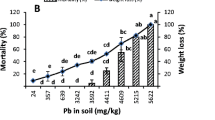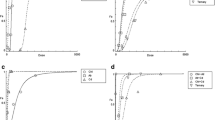Abstract
Purpose
The presence of one metal can alter the toxicity of another metal by having an additive, synergistic, or antagonistic impact. Mixed metal pollution has clear ecological consequences. The importance of use of earthworms for ecological health monitoring is recognized widely. This study investigated the effect of binary and tertiary metal mixtures on the toxicity, bioaccumulation, and reproduction of the Eisenia fetida in different South Australian soils.
Materials and methods
The end points used in this 56-day reproduction study were avoidance behavior, worm mortality, weight loss, reproduction, and metal (Cd, Zn, and Pb) bioaccumulation. The three soils (acidic, neutral, and alkaline) were spiked with selected binary and tertiary concentration mixtures that considered the soil quality guideline values, EC50 and LC50 values for Cd, Zn, and Pb obtained from the previous single metal earthworm experiments done by the authors.
Results and discussion
In acidic soil, Zn and Cd constituted the most toxic metal combination to earthworms. However, in contrast to this observation, the same metal combination was the least toxic one to earthworms in neutral and alkaline soils. For Zn and Pb spiked soils, relationships between soil and internal metal concentrations were found with R 2 = 0.63, r = 0.8, and R 2 = 0.94, p < 0.01, respectively, for Zn and Pb. This study indicates that earthworms have high tendency to bioaccumulate heavy metals in their tissues and hence serves as ecological indicators of soil heavy metal contamination. The highest bioaccumulation factor (0–9) was evident for Cd in contaminated soils. This study demonstrated the role of soil edaphic factors and metal-metal interactions in the toxicity of metal mixtures to E. fetida.
Conclusions
In Zn and Pb binary mixture spiked acidic soil, mortality of 60% was recorded even when the Pb and Zn concentrations were below the Canada and Dutch EIL (ecological investigational levels) values. This indicates the current guideline values are not safe for mixed metal toxicity. Therefore, care must be taken when predicting metal toxicities in mixed metal contaminated soils.




Similar content being viewed by others
References
Banni M, Jebali J, Guerbej H, Dondero F, Boussetta H, Viarengo A (2011) Mixture toxicity assessment of nickel and chlorpyrifos in the sea bass Dicentrarchus labrax. Arch Environ Contam Toxicol 60(1):124–131. https://doi.org/10.1007/s00244-010-9529-y
Bradham KD, Dayton EA, Basta NT, Schroder J, Payton M, Lanno RP (2006) Effect of soil properties on lead bioavailability and toxicity to earthworms. Environ Toxicol Chem 25(3):769–775. https://doi.org/10.1897/04-552R.1
Brzóska M, Moniuszko-Jakoniuk J (2001) Interactions between cadmium and zinc in the organism. Food Chem Toxicol 39(10):967–980. https://doi.org/10.1016/S0278-6915(01)00048-5
Button M, Jenkin GR, Harrington CF, Watts MJ (2009) Arsenic biotransformation in earthworms from contaminated soils. J Environ Monit 11(8):1484–1491. https://doi.org/10.1039/b904104d
Cáceres T, Megharaj M, Venkateswarlu K, Sethunathan N, Naidu R (2010) Fenamiphos and related organophosphorus pesticides: environmental fate and toxicology. Springer
Cartwright B, Merry R, Tiller K (1977) Heavy metal contamination of soils around a lead smelter at Port Pirie, South Australia. Aust J Soil Res 15(1):69–81. https://doi.org/10.1071/SR9770069
Conder JM, Lanno RP (2003) Lethal critical body residues as measures of Cd, Pb, and Zn bioavailability and toxicity in the earthworm Eisenia fetida. J Soils Sediments 3(1):13–20. https://doi.org/10.1007/BF02989463
Darling CTR, Thomas VG (2005) Lead bioaccumulation in earthworms, Lumbricus terrestris, from exposure to lead compounds of differing solubility. Sci Total Environ 346(1-3):70–80. https://doi.org/10.1016/j.scitotenv.2004.11.011
Duong TTT, Lee B-K (2011) Determining contamination level of heavy metals in road dust from busy traffic areas with different characteristics. J Environ Manag 92(3):554–562. https://doi.org/10.1016/j.jenvman.2010.09.010
Ernst G, Zimmermann S, Christie P, Frey B (2008) Mercury, cadmium and lead concentrations in different ecophysiological groups of earthworms in forest soils. Environ Pollut 156(3):1304–1313. https://doi.org/10.1016/j.envpol.2008.03.002
Kim K, Owens G, Naidu R (2009) Heavy metal distribution, bioaccessibility, and phytoavailability in long-term contaminated soils from Lake Macquarie, Australia. Aust J Soil Res 47(2):166–176. https://doi.org/10.1071/SR08054
Kojima Y, Kägi JH (1978) Metallothionein. Trends Biochem Sci 3(2):90–93. https://doi.org/10.1016/S0968-0004(78)80006-1
Lokke H, Gestel CAM (1998) Handbook of soil invertebrate toxicity tests. Ecological & environmental toxicology series. John Wiley and Sons Ltd Chichester (United Kingdom), pp 281–285
Morgan A, Morris B (1982) The accumulation and intracellular compartmentation of cadmium, lead, zinc and calcium in two earthworm species (Dendrobaena rubida and Lumbricus rubellus) living in highly contaminated soil. Histochemistry 75(2):269–285. https://doi.org/10.1007/BF00496017
Nederlof M, Van Riemsdijk W, De Haan F 1993 Effect of pH on the bioavailability of metals in soils. Integrated sSoil and sSediment rResearch: aA bBasis for pProper pProtection. Springer, pp 215– 219
Pelfrene A, Waterlot C, Mazzuca M, Nisse C, Bidar G, Douay F (2011) Assessing Cd, Pb, Zn human bioaccessibility in smelter-contaminated agricultural topsoils (northern France). Environ Geochem Health 33(5):477–493. https://doi.org/10.1007/s10653-010-9365-z
Qiu H, Vijver MG, Peijnenburg WJ (2011) Interactions of cadmium and zinc impact their toxicity to the earthworm Aporrectodea caliginosa. Environ Toxicol Chem 30(9):2084–2093. https://doi.org/10.1002/etc.595
Sheng PX, Ting Y-P, Chen JP, Hong L (2004) Sorption of lead, copper, cadmium, zinc, and nickel by marine algal biomass: characterization of biosorptive capacity and investigation of mechanisms. J Colloid Interf Sci 275(1):131–141. https://doi.org/10.1016/j.jcis.2004.01.036
Stephenson G, Kaushik A, Kaushik N, Solomon K, Steele T, Scroggins R (1998) Use of an avoidance-response test to assess the toxicity of contaminated soils to earthworms. Advances in earthworm ecotoxicology. SETAC, Pensacola, FL, USA, pp 67–81
van der Geest HG, Greve GD, Boivin ME, Kraak MH, van Gestel CA (2000) Mixture toxicity of copper and diazinon to larvae of the mayfly (Ephoron virgo) judging additivity at different effect levels. Environ Toxicol Chem 19(12):2900–2905. https://doi.org/10.1002/etc.5620191208
Weltje L (1998) Mixture toxicity and tissue interactions of Cd, Cu, Pb and Zn in earthworms (Oligochaeta) in laboratory and field soils: a critical evaluation of data. Chemosphere 36(12):2643–2660. https://doi.org/10.1016/S0045-6535(97)10228-4
Wijayawardena MA, Megharaj M, Naidu R (2017) Bioaccumulation and toxicity of lead, influenced by edaphic factors: using earthworms to study the effect of Pb on ecological health. J Soils Sediments 17(4):1064–1072. https://doi.org/10.1007/s11368-016-1605-0
Wu B, LiuZ XY, Li D, Li M (2012) Combined toxicity of cadmium and lead on the earthworm Eisenia fetida (Annelida, Oligochaeta). Ecotoxicol Environ Saf 81:122–126. https://doi.org/10.1016/j.ecoenv.2012.05.003
Xian X, Shokohifard GI (1989) Effect of pH on chemical forms and plant availability of cadmium, zinc, and lead in polluted soils. Water Air Soil Pollut 45:265–273
Acknowledgements
All the authors would like to thank C. Danidu Kudagamage for helping with the earthworm experiments.
Funding
This study was funded through a CRCCARE postgraduate scholarship.
Author information
Authors and Affiliations
Corresponding author
Additional information
Responsible editor: Sung-Eun Lee
Electronic supplementary material
ESM 1
(DOCX 18 kb)
Rights and permissions
About this article
Cite this article
Ayanka Wijayawardena, M.A., Megharaj, M., Naidu, R. et al. Chronic and reproductive toxicity of cadmium, zinc, and lead in binary and tertiary mixtures to the earthworm (Eisenia fetida). J Soils Sediments 18, 1602–1609 (2018). https://doi.org/10.1007/s11368-017-1877-z
Received:
Accepted:
Published:
Issue Date:
DOI: https://doi.org/10.1007/s11368-017-1877-z




